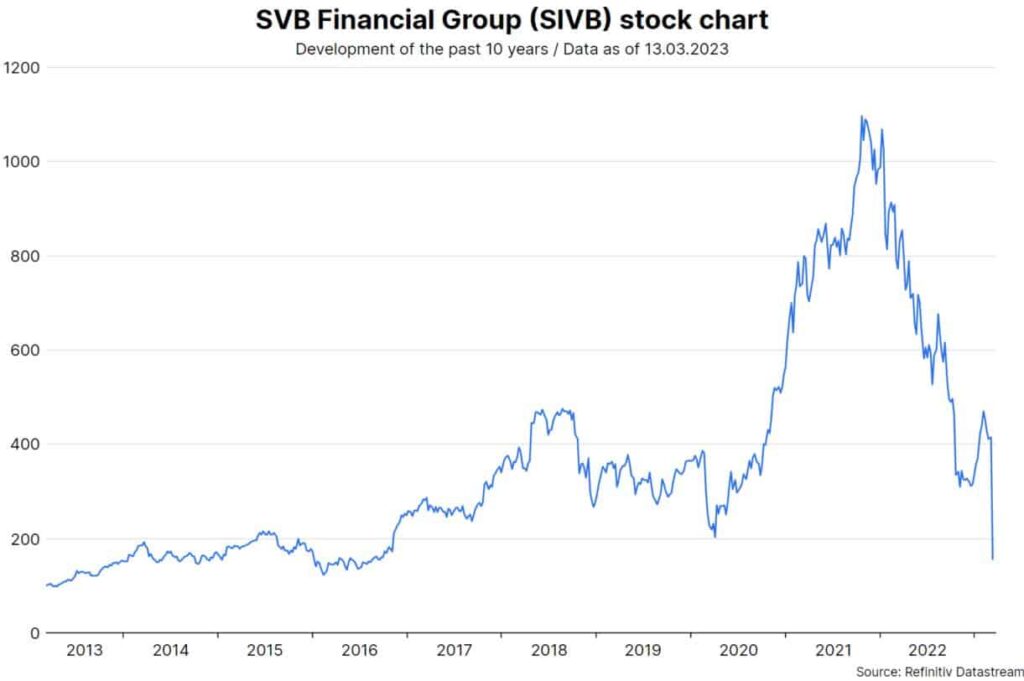The turbulences surrounding the US Silicon Valley Bank (SVB) are currently keeping the markets busy. After the bank was closed last Friday, a comprehensive package of measures followed over the weekend to avoid possible consequences. In this blog post, the experts of our Investment Division explain what exactly happened and how they assess the situation.
What had happened?
Silicon Valley Bank (SVB), headquartered in Santa Clara, California, specialized in financial services for startups and high tech companies. In recent days and weeks, the bank has been confronted with increased outflows of deposits from customers. As a result, approximately USD 20 billion worth of bonds that the bank held as investments were sold to cover the outflows. These bonds were primarily credit-backed government and mortgage bonds. According to media reports, these were purchased by Silicon Valley Bank during the Corona crisis. Although these bonds had little to no credit risk, they still had longer maturities. As a result, they had a higher sensitivity to yield increases.
Due to the general increase in yields since the beginning of 2022, the price of these bonds fell significantly, forcing the bank to realize losses on these positions. This in turn triggered concerns among depositors that the bank could face insolvency problems, which led even more customers to withdraw their funds.
On Friday evening (European time), the bank’s bankruptcy was sealed. Customers had requested withdrawals in the amount of USD 42 billion in a single day, representing about a quarter of the bank’s total deposits. Silicon Valley Bank was unable to service these outflows.

How did the markets react?
The Federal Deposit Insurance Corporation (the US banking regulator that guarantees deposits up to USD 250,000) then declared the company insolvent and took over its control. The rush of customers had become so great that the bank’s coffers were completely emptied and it had a “negative cash balance” of USD 1 billion.
In the last trading sessions, the markets reacted volatile to the problems around the Silicon Valley Bank. The US leading index S&P 500 lost about 3.2% on Thursday and Friday, at the start of the week on Monday it lost a slight 0.2%. Yields on 10-year US Treasury bonds fell 40 basis points to around 3.6%. In our view, the latter is
- on a “flight to the safe haven” (US government bonds) and
- on the expectation of postponed key interest rate increases
due to the bankruptcy. In addition, another bank (Signature Bank) went bankrupt on Sunday.
What measures did the authorities take?
Over the weekend, the authorities in the USA also intervened. Late Sunday evening, the US Treasury, the Federal Deposit Insurance Corporation and the Fed announced joint measures. A new program (Bank Term Funding Program) was announced that provides liquidity to institutions. Banks can deposit government bonds and other financial instruments as collateral under this program. The collateral can be deposited at nominal value rather than at market price. In this way, forced sales, as happened with SVB, are to be avoided. In addition, SVB depositors were given access to all their funds on Monday, including balances exceeding the FDIC guarantee threshold of USD 250,000.
How do we assess the situation?
We assume that the policy measures announced so far are a clear sign that the US government is doing everything in its power to prevent a systemic crisis in the US banking sector. There are currently no classic signs of contagion to other institutions, such as additional stress in the interbank market. According to the Financial Times, the estimated unrealized losses in the US banking sector amount to approximately USD 620 billion. This compares with equity capital of the entire sector of approximately USD 2.2 trillion.
In addition, Silicon Valley Bank (SVB) also differs significantly from major US banks in its business model. The focus of this bank is on business customers from the technology and start-up sectors.
Nevertheless, the situation at Silicon Valley Bank is a reminder that the Fed’s rate hikes are having an impact, even though the economy has held up well so far. The risk, in our view, is that the cost of capital for banks, and thus for companies, could rise on a sustained basis. As a result, lending rates could also move further upward. In our view, this has also made an acceleration of the interest rate hike cycle less likely after the head of the US Federal Reserve, Powell, made inflation-fighting statements in two speeches to subcommittees of the US Congress.
For a glossary of technical terms, please visit this link: Fund Glossary | Erste Asset Management
Legal note:
Prognoses are no reliable indicator for future performance.

